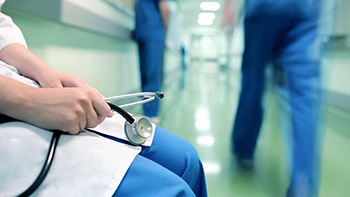In IVF treatment, ovarian stimulation is done through injections of gonadotropins, i.e. follicle-stimulating hormone (FSH) and luteinizing hormone (LH). Gonadotropins stimulate and support follicular development in the ovary. The gonadotropin dose depends on your age, weight, and ovarian reserve. Typically, you will receive gonadotropin injections for about ten days before you are ready for your egg collection. The first few days of treatment with gonadotropins are usually symptom-free. However, after about seven days of treatment, some patients experience lower abdominal tenderness and bloating.
We will schedule your egg retrieval when you have more significant follicles than 17-18 mm in diameter. That evening, you will receive an injection to complete the maturation of the eggs. Your egg retrieval will take place precisely thirty-six hours after this injection.
Egg Collection
This procedure may cause some discomfort. The day before your procedure, we will prescribe you an anti-anxiety medication called Ativan. This medication will help you get a good night’s sleep and be relaxed during your procedure. You will need to fast (no food or drink) from midnight the day before and arrive at the centre one hour before your procedure. When you arrive, you will be taken to your pre-operative room; a nurse will take your vital signs and insert an intravenous catheter.
Following egg retrieval, we will keep you under observation in our recovery room for 1-2 hours, and then you will be able to go home. You will know the total number of eggs retrieved before you leave. You will also receive your first dose of progesterone before you leave. Once you are home, relax and go to bed early. It is not uncommon for patients to experience some abdominal discomfort as well as vaginal tenderness and vaginal bleeding in the evening following the procedure.
Fertilization And Embryo Transfer
In a traditional IVF, sperm are prepared and placed in contact with your eggs several hours after collection. Afterwards, the sperm and eggs are left in an incubator overnight so that fertilization can occur. We will call you the day after collection to inform you how many eggs were fertilized. We will also call you the following day to arrange your transfer day. Embryo transfer will occur 2, 3 or 5 days after egg collection. The decision will depend on the number and quality of embryos obtained. Generally, if there are several very high-quality embryos, we will transfer them on day 5. Otherwise, with a limited number of high-quality embryos, we may transfer them 2 to 3 days after your collection.
Embryo transfer into the uterus using a very flexible plastic tube (catheter) under ultrasound guidance. The procedure lasts only a few minutes and is usually painless.
After Embryo Transfer
We would recommend that you limit your activities for 24-48 hours after embryo transfer. You can gradually increase the intensity of your activities over the next few days. Many women return to work after a few days if their job is not stressful, while others prefer to rest.
You will return to the Genova Fertility Center Lahore two weeks after your egg retrieval to have a blood pregnancy test. If the result is positive, we will ask you to continue taking your progesterone supplements, and a second blood test will be scheduled 48-72 hours later. We will perform an ultrasound approximately four weeks after the egg retrieval and may repeat it two to three times during the first trimester of your pregnancy. Afterward, you will return to your referring physician for the remainder of your pregnancy follow-up.
Intracytoplasmic Sperm Injection (ICSI)
With this technique, an embryologist injects a single sperm into each available mature egg using a specially designed glass needle. ICSI treatment makes fertilization possible even for patients with very few sperm in their ejaculate or testicles. The probability of achieving pregnancy is comparable to that of IVF.
Blastocyst Culture
When many good-quality embryos are obtained, patients can be offered to keep them in long-term culture until day 5. By this time, only the strongest embryos will have reached the blastocyst stage. A blastocyst is an embryo that looks like a hollow, transparent ball and contains more than 60 cells. Patients who undergo blastocyst transfer have an excellent chance of becoming pregnant.

